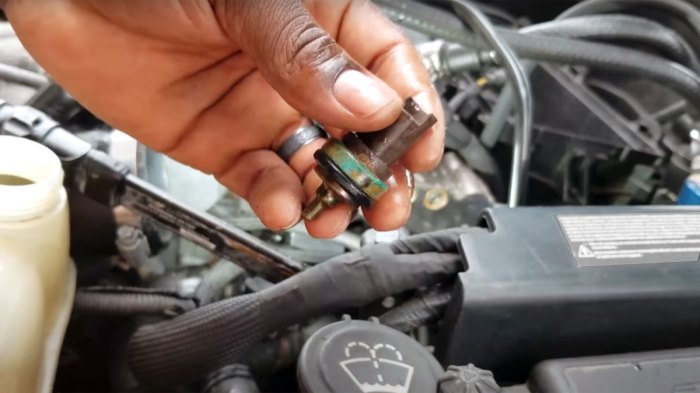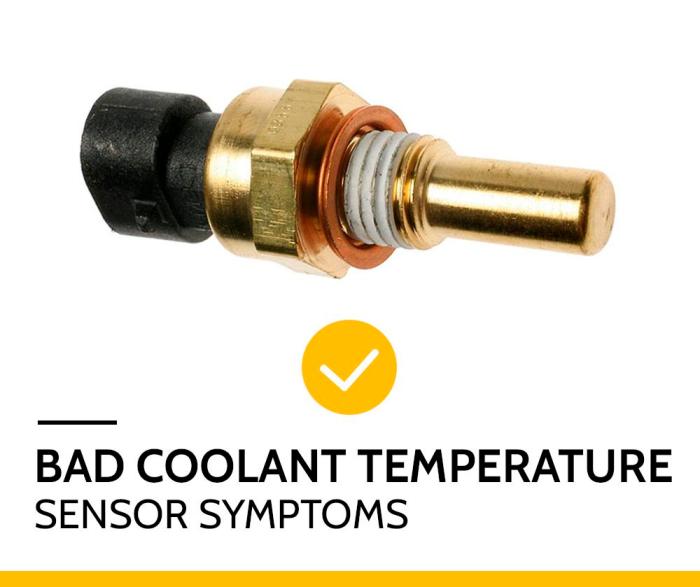A malfunctioning car coolant temperature sensor can significantly impact your vehicle’s performance and fuel efficiency. This seemingly small component plays a crucial role in regulating engine temperature, and its failure can manifest in a variety of subtle yet important ways. Understanding these symptoms is key to preventing more serious engine damage and costly repairs. This guide will explore nine common indicators that your coolant temperature sensor might be on its way out.
From erratic engine behavior to unexpected fuel consumption changes, the consequences of a faulty sensor can range from inconvenient to potentially catastrophic. By learning to recognize these warning signs, you can take proactive steps to maintain your vehicle’s health and avoid unexpected breakdowns. This guide aims to equip you with the knowledge to identify and address this issue effectively.
Understanding the Car Coolant Temperature Sensor’s Role

The car coolant temperature sensor (CTS) plays a vital role in maintaining optimal engine operating temperature and fuel efficiency. It acts as a crucial link between the engine’s cooling system and the engine control unit (ECU), providing real-time data on the coolant’s temperature. This information allows the ECU to make critical adjustments to fuel delivery, ignition timing, and other engine parameters.
The CTS is a small, relatively inexpensive component, but its failure can lead to significant problems. A malfunctioning sensor can cause the ECU to receive inaccurate temperature readings, resulting in a cascade of negative effects on engine performance and fuel economy. The consequences range from minor drivability issues to serious engine damage if left unaddressed. Understanding its function and potential failures is crucial for maintaining vehicle health.
Consequences of a Malfunctioning Coolant Temperature Sensor
A faulty CTS can lead to a range of issues, impacting both engine performance and fuel efficiency. For instance, an inaccurate reading might cause the ECU to enrich the fuel mixture unnecessarily, leading to poor fuel economy and increased emissions. Conversely, an incorrect reading might cause the ECU to delay the activation of the cooling fan, potentially leading to engine overheating. In some cases, a faulty CTS can trigger the check engine light, providing a clear indication of a problem. The severity of the consequences depends on the nature and extent of the sensor malfunction. A sensor reporting consistently low temperatures might lead to rich fuel mixtures and poor performance, while a sensor reporting consistently high temperatures could lead to engine damage from overheating.
Comparing CTS Symptoms with Other Engine Cooling System Problems
Differentiating symptoms caused by a faulty CTS from other engine cooling system problems requires careful observation and analysis. While a faulty thermostat might also cause overheating, it usually does so in a more consistent manner, often leading to immediate and persistent high temperatures. A failing water pump, on the other hand, may cause overheating only under high load conditions, such as prolonged uphill driving or towing. A leak in the cooling system, meanwhile, will often manifest as a visible coolant loss, sometimes accompanied by steam or a sweet smell. A faulty CTS, however, can produce a wider range of erratic symptoms, making diagnosis more challenging.
Symptom Analysis of a Failing Coolant Temperature Sensor
The following table summarizes common symptoms associated with a failing coolant temperature sensor, their severity, and recommended actions.
| Symptom | Cause (related to sensor failure) | Severity | Recommended Action |
|---|---|---|---|
| Check Engine Light illuminated | Inaccurate temperature readings sent to the ECU triggering a diagnostic trouble code (DTC) | Medium | Have the DTC code read and addressed by a mechanic. |
| Poor fuel economy | ECU uses inaccurate temperature data, leading to incorrect fuel mixture adjustments. | Medium | Inspect the CTS and replace if faulty. |
| Rough idle or stalling | ECU receives incorrect temperature data, affecting idle speed control. | Medium | Inspect and replace the CTS if needed. |
| Erratic temperature gauge readings | Sensor provides intermittent or inaccurate temperature readings. | Medium to High | Diagnose and replace the CTS. Monitor engine temperature closely. |
Nine Common Symptoms of a Failing Coolant Temperature Sensor

A malfunctioning coolant temperature sensor can lead to a range of issues impacting your vehicle’s performance and efficiency. These problems often manifest subtly at first, but ignoring them can lead to more significant engine damage. Accurate diagnosis is crucial to prevent costly repairs. Understanding the common symptoms allows for timely intervention and prevents escalating problems.
Erratic Temperature Gauge Readings
A faulty sensor frequently results in inaccurate readings on the vehicle’s temperature gauge. The gauge might fluctuate wildly, show abnormally high or low temperatures, or remain pegged at a single point regardless of the engine’s actual operating temperature. For example, a car might show a consistently low temperature reading even after prolonged driving, leading the driver to believe the engine is not overheating when it actually is. This inaccurate information can mislead the driver, potentially leading to engine damage due to overheating.
Engine Overheating
While a low temperature reading is common, a failing sensor can also cause the engine to overheat. This occurs if the sensor signals a lower temperature than reality to the Engine Control Unit (ECU). The ECU, believing the engine is cooler than it is, may not activate the cooling fan or delay its activation, leading to overheating and potential engine damage. One real-world example involved a vehicle experiencing repeated overheating incidents, despite seemingly normal coolant levels. Replacement of the coolant temperature sensor resolved the problem immediately.
Poor Fuel Economy
An inaccurate temperature reading provided by the sensor can cause the ECU to adjust the air-fuel mixture improperly. This leads to inefficient combustion and a noticeable decrease in fuel economy. A driver might observe a significant drop in miles per gallon without any other apparent mechanical issues. A case study showed a vehicle experiencing a 20% reduction in fuel efficiency, traced back to a faulty sensor sending inaccurate temperature data to the ECU, leading to a richer than optimal fuel mixture.
Rough Idling or Stalling
The ECU relies on the coolant temperature sensor’s input to determine the ideal engine idle speed and fuel delivery. A malfunctioning sensor can cause erratic idling, rough running, and even stalling, particularly when the engine is cold. A vehicle experiencing intermittent stalling at traffic lights, only to run smoothly once the engine warmed up, had its issue resolved by replacing the faulty sensor. The cold start issue was directly related to the sensor’s inaccurate temperature reading.
Check Engine Light Illumination
The most common indicator of a problem is the illumination of the check engine light. The onboard diagnostics (OBD-II) system will detect a fault in the sensor’s readings and store a diagnostic trouble code (DTC). Many vehicles will trigger a check engine light when the sensor readings fall outside of a predetermined range. The code will often specifically point to the coolant temperature sensor, aiding in diagnosis.
Delayed or Inconsistent Warm-up
A malfunctioning sensor can cause the engine to take longer than usual to reach its optimal operating temperature. This delay can result in reduced engine performance and increased emissions. In a specific instance, a vehicle owner noted a consistently sluggish engine response during the first few minutes of driving, a direct result of the sensor providing inaccurate temperature data, preventing the ECU from adjusting the fuel mixture correctly.
Hesitation or Lack of Power
In some cases, a faulty sensor can lead to hesitation during acceleration or a noticeable lack of power. The inaccurate temperature reading interferes with the ECU’s ability to optimize fuel delivery and ignition timing, resulting in reduced performance. A driver experiencing sluggish acceleration and a noticeable drop in power, particularly during initial acceleration, had the issue rectified by a simple sensor replacement.
Increased Emissions
A faulty sensor can negatively impact the engine’s combustion process, leading to increased emissions of pollutants like carbon monoxide and hydrocarbons. This can result in a failed emissions test. An example of this is a vehicle failing its annual emissions test due to high hydrocarbon levels, only to pass after the coolant temperature sensor was replaced. The inaccurate temperature data caused improper fuel mixture, leading to incomplete combustion.
Difficulty Starting (Cold Engine)
A sensor providing inaccurate cold engine temperature readings can hinder the engine’s starting process. The ECU might adjust the fuel mixture incorrectly based on faulty data, leading to difficulty starting the engine, particularly in cold weather. A vehicle consistently requiring multiple cranking attempts to start in cold temperatures, especially in the mornings, had its problem eliminated by replacing the faulty coolant temperature sensor.
Troubleshooting and Repairing a Faulty Coolant Temperature Sensor

Diagnosing and repairing a malfunctioning coolant temperature sensor requires a systematic approach, combining diagnostic tools with hands-on mechanical skills. Accurate diagnosis is crucial to prevent further engine damage and ensure the vehicle’s safe operation. This section details the process of identifying a faulty sensor, replacing it, and addressing potential complications.
Diagnostic Tools and Techniques
Confirming a failing coolant temperature sensor often involves a combination of methods. A simple visual inspection can reveal obvious signs of damage, such as corrosion or loose wiring. However, more sophisticated diagnostic tools are usually necessary for a definitive diagnosis. An OBD-II scanner can retrieve diagnostic trouble codes (DTCs) from the vehicle’s onboard computer. Specific codes related to coolant temperature sensor circuit malfunctions will point towards a potential issue. Furthermore, a multimeter can be used to measure the sensor’s resistance at various temperatures. This involves comparing the measured resistance to the sensor’s specifications provided by the manufacturer or in a repair manual. A deviation from the expected resistance values indicates a faulty sensor. In some cases, a temperature gun can be used to verify the actual coolant temperature and compare it to the reading provided by the sensor. Discrepancies between these values suggest a malfunctioning sensor.
Coolant Temperature Sensor Replacement Procedure
Replacing a coolant temperature sensor is a relatively straightforward procedure, but safety precautions must be observed. Before beginning, ensure the engine is completely cool to prevent burns. The necessary tools typically include a socket wrench (size will vary depending on the vehicle), a new coolant temperature sensor, and possibly some rags or towels for cleanup. First, locate the sensor, typically found on the engine block or cylinder head near the thermostat housing. Disconnect the sensor’s electrical connector. Next, carefully unscrew the sensor using the appropriate socket wrench. Sometimes, the sensor may be stuck due to corrosion; penetrating oil can help loosen it. Once removed, install the new sensor, ensuring a snug fit. Reconnect the electrical connector. Finally, top off the coolant reservoir if necessary and monitor the engine temperature gauge during operation to confirm proper functionality.
Coolant Temperature Sensor Types and Comparisons
Coolant temperature sensors come in various types, primarily differing in their sensing technology. Thermistor-based sensors are common; their resistance changes with temperature. Other types include thermistor-based sensors, and more recently, some manufacturers are incorporating digital sensors. The choice of sensor depends on the vehicle’s make and model. It’s crucial to use a replacement sensor that matches the original specifications. Direct replacement is usually recommended to avoid compatibility issues. A mismatch could lead to inaccurate temperature readings and potential engine damage.
Potential Complications During Sensor Replacement and Solutions
Several complications can arise during coolant temperature sensor replacement. One common problem is difficulty removing the sensor due to corrosion or seizing. Penetrating oil applied several hours before removal can help. Another potential issue is damaging the sensor threads during installation. Carefully threading the sensor by hand initially, before tightening with a wrench, can help prevent this. Stripped threads might require a helicoil or other repair methods. Incorrectly connecting the electrical connector could lead to further problems. Ensure the connector is firmly seated and properly locked into place. Finally, incorrect sensor selection can result in inaccurate temperature readings and engine problems. Always use a replacement sensor with identical specifications to the original.
Final Conclusion

Ignoring the warning signs of a failing coolant temperature sensor can lead to more extensive and costly engine problems. Regular vehicle maintenance, including periodic checks of this crucial component, is vital for preventing serious issues. By familiarizing yourself with the nine common symptoms discussed, you’re empowered to identify potential problems early and take appropriate action. Remember, proactive maintenance is the key to ensuring your vehicle’s longevity and optimal performance.